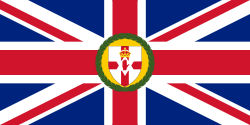Governor of Northern Ireland facts for kids
Quick facts for kids Governor of Northern Ireland |
|
|---|---|
 |
|
| Style | Excellency |
| Residence | Hillsborough Castle |
| Appointer | British Monarch |
| Precursor | Lord Lieutenant of Ireland |
| Formation | 9 December 1922 |
| First holder | The 3rd Duke of Abercorn |
| Final holder | The Lord Grey of Naunton |
| Abolished | 18 July 1973 |
| Succession | Secretary of State for Northern Ireland |
The Governor of Northern Ireland was a very important official. They represented the British monarch (the King or Queen) in Northern Ireland. This job was created on December 9, 1922. It ended on July 18, 1973.
Contents
What the Governor Did
The job of Governor of Northern Ireland began with a special document. This document was like a royal order from the King. It said the Governor would take over many duties. These duties used to belong to the Lord Lieutenant of Ireland. The Lord Lieutenant was the King's representative for all of Ireland before it was divided.
The Governor's main role was mostly ceremonial. This means they had important duties but didn't make political decisions. They acted on the advice of the Northern Ireland government.
Governor's Powers and Duties
The Governor had several important tasks:
- They would officially open and close the Parliament of Northern Ireland. This Parliament met at Stormont Castle.
- They would give the "speech from the throne." This speech outlined the government's plans for the year.
- The Governor was in charge of the Great Seal of Northern Ireland. This seal was used to make official documents valid.
- They could also show "mercy" to people. This meant they could reduce punishments for crimes.
- The Governor gave royal assent to new laws. This made bills passed by Parliament official laws.
Even though the Governor had the power to stop or delay laws, they never used it. One time, before the Governor's job started, the Lord Lieutenant did question a law. This law changed how local elections worked. But even then, the law was passed. This showed that London usually didn't interfere much with Northern Ireland's laws.
Governor's Role in Politics
The Governor was not usually involved in daily politics. However, there were a few times when they played a part.
- In 1951, a Governor's visit to Londonderry caused a protest. People were upset about how voting areas were unfairly drawn.
- In 1963, when the Prime Minister of Northern Ireland resigned, Governor Baron Wakehurst helped choose the next leader. This was similar to how the Queen chose the UK Prime Minister that same year.
- In the 1960s, a Governor named Lord Erskine helped get a new bridge in Belfast named after Queen Elizabeth II. Some people who supported the British connection were unhappy. They wanted it named after a local hero. This showed some early signs of the problems that would later become known as the Troubles.
Official Home
The official home for the Governor of Northern Ireland was Hillsborough Castle. This beautiful castle is located in County Down. The first Governor, the Duke of Abercorn, moved into the castle in 1925. It remained the Governor's home until the job was ended in 1973. Today, Hillsborough Castle is the official residence of the Secretary of State for Northern Ireland.
Governors of Northern Ireland (1922–1973)
A Governor usually served for six years. They could serve for more terms if they wished. This rule was similar to the one for the Lord Lieutenant.
| No. | Portrait | Name (Born–Died) |
Time in Office | Monarch | Prime Minister | ||
|---|---|---|---|---|---|---|---|
| Started | Ended | Length of Service | |||||
| 1 |  |
James Hamilton, 3rd Duke of Abercorn (1869–1953) |
12 December 1922 | 6 September 1945 | 22 years, 268 days | George V Edward VIII George VI |
Craigavon Andrews Brooke |
| 2 |  |
William Leveson-Gower, 4th Earl Granville (1880–1953) |
7 September 1945 | 1 December 1952 | 7 years, 85 days | George VI Elizabeth II |
Brooke |
| 3 |  |
John Loder, 2nd Baron Wakehurst (1895–1970) |
3 December 1952 | 1 December 1964 | 11 years, 364 days | Elizabeth II | Brookeborough O'Neill |
| 4 |  |
John Erskine, 1st Baron Erskine of Rerrick (1893–1980) |
3 December 1964 | 2 December 1968 | 3 years, 365 days | O'Neill | |
| 5 | Ralph Grey, Baron Grey of Naunton (1910–1999) |
3 December 1968 | 18 July 1973 | 4 years, 205 days | O'Neill Chichester-Clark Faulkner |
||
Deputy Governors
When the Governor had to leave Northern Ireland, they needed permission from the monarch. They could then appoint "Deputies" to act in their place. These deputies were formally called "Lords Justices for the government of Northern Ireland." They were often important judges or senators.
Some of the people who served as deputies included:
- Denis Henry
- William Moore
- James Andrews
- Anthony Babington
- John MacDermott, Baron MacDermott
- Samuel Clarke Porter
- Robert Sharman-Crawford
- Robert David Perceval-Maxwell
- Henry Armstrong
- Sir Thomas Dixon, 2nd Baronet
- Maurice McCausland
- Francis Needham, 4th Earl of Kilmorey
See Also
- Lord Lieutenant of Ireland
- Governor-General of the Irish Free State

